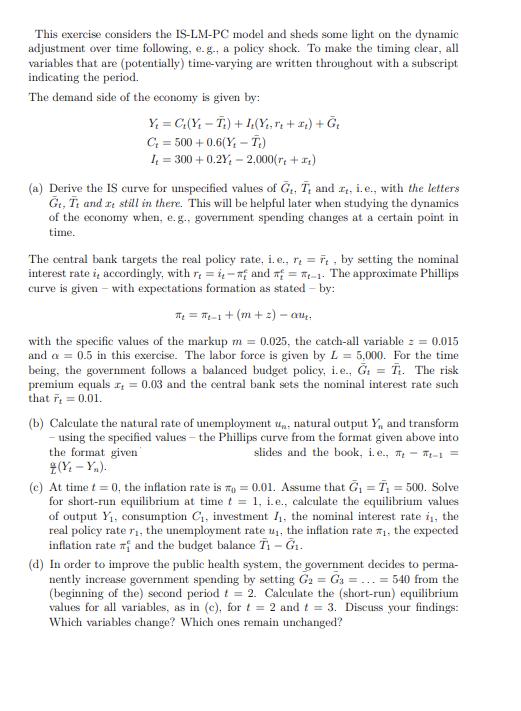Answered step by step
Verified Expert Solution
Question
1 Approved Answer
This exercise considers the IS-LM-PC model and sheds some light on the dynamic adjustment over time following, e. g., a policy shock. To make

This exercise considers the IS-LM-PC model and sheds some light on the dynamic adjustment over time following, e. g., a policy shock. To make the timing clear, all variables that are (potentially) time-varying are written throughout with a subscript indicating the period. The demand side of the economy is given by: Y = C(Y-T) +1(Y, +x) + G C = 500+0.6(YT) I = 300+ 0.2Y - 2,000(+) (a) Derive the IS curve for unspecified values of G, T, and , i.e., with the letters Gt, T and re still in there. This will be helpful later when studying the dynamics of the economy when, e. g., government spending changes at a certain point in time. The central bank targets the real policy rate, i.e., r = 7, by setting the nominal interest rate i, accordingly, with r = -f and f = -1. The approximate Phillips curve is given - with expectations formation as stated - by: T = _1 + (m + 2) -am, with the specific values of the markup m = 0.025, the catch-all variable z = 0.015 and a 0.5 in this exercise. The labor force is given by L = 5,000. For the time being, the government follows a balanced budget policy, i.e., G = T. The risk premium equals r = 0.03 and the central bank sets the nominal interest rate such that F, = 0.01. (b) Calculate the natural rate of unemployment u, natural output Y, and transform - using the specified values - the Phillips curve from the hat given above into the format given slides and the book, i.e., - -1 = (Y-Y). (c) At time t = 0, the inflation rate is = 0.01. Assume that G = T = 500. Solve for short-run equilibrium at time t = 1, i.e., calculate the equilibrium values of output Y, consumption C, investment I, the nominal interest rate i, the real policy rate r, the unemployment rate u, the inflation rate , the expected inflation rate r and the budget balance Ti - G. (d) In order to improve the public health system, the government decides to perma- nently increase government spending by setting G = Ga=... = 540 from the (beginning of the) second period t = 2. Calculate the (short-run) equilibrium values for all variables, as in (c), for t = 2 and t = 3. Discuss your findings: Which variables change? Which ones remain unchanged?
Step by Step Solution
★★★★★
3.45 Rating (161 Votes )
There are 3 Steps involved in it
Step: 1
a To derive the IS curve for unspecified values of overlineGt overlineTt and xt we use the given spe...
Get Instant Access to Expert-Tailored Solutions
See step-by-step solutions with expert insights and AI powered tools for academic success
Step: 2

Step: 3

Ace Your Homework with AI
Get the answers you need in no time with our AI-driven, step-by-step assistance
Get Started


